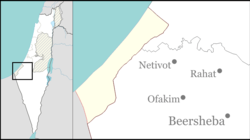Nir Oz
|
Nir Oz
נִיר עֹז
| |
|---|---|
 Nir Oz  Nir Oz | |
| Coordinates: 31°18′37″N 34°24′8″E | |
| Country | Israel |
| District | Southern |
| Council | Eshkol |
| Affiliation | Kibbutz Movement |
| Founded | 1 October 1955 |
| Founded by | Nahal |
| Population
(2021)
|
393 |

Nir Oz (Hebrew: נִיר עֹז, ניר עוז, lit. 'Meadow of Strength') is a kibbutz in southern Israel. It is located in the northwestern Negev desert between Magen and Nirim, and covers 20,000 dunams. Nir Oz is under the jurisdiction of Eshkol Regional Council. In 2021 it had a population of 393.
History
Founded on 1 October 1955 as a Nahal settlement, Nir Oz was recognized as a kibbutz two months later. According to a resident named Shlomo Margalit in 2013, there had been a moshav on the site around 1952, "but too many members were killed by the fedayeen or left, so it was dissolved." There were only four trees growing at the kibbutz at the time of its founding; it was developed over time into a model for low-water landscaping. The Hashomer Hatzair took over Nir Oz in May 1957, with a founding group of 70 members.
Due to its proximity to Gaza, Nir Oz farmers often come under Palestinian sniper fire. In 2008 the Israel Defense Forces (IDF) asked the kibbutz to harvest its potatoes at night to lower the risk of attack. On 5 June 2008 a mortar bomb fired from the Gaza Strip hit the Nirlat paint factory on the kibbutz, killing an employee and wounding four others. Hamas claimed responsibility for the attack. Around 2013 a tunnel from Gaza was found near Nir Oz. A 2023 book reported that the village had a number of "self-contained bomb shelters, each weighing 67 tons."
2023 Hamas massacre
In the 7 October 2023 surprise attack on the Gaza border communities, Hamas either killed, injured or abducted and taken into Gaza about one quarter of the 400 residents of Nir Oz. The Hamas assault on the kibbutz was over by 1 pm, and it took the IDF another two hours to reach Kibbutz Nir Oz. The surviving kibbutz members were evacuated to Eilat. According to the New York Times, "no one lives in Kibbutz Nir Oz anymore".
The residents of Nir Oz are currently living in temporary housing. The authority responsible for the rehabilitation of Israeli communities affected by the Hamas attack has estimated that it will take two years to fully rebuild Nir Oz.
Economy
Like almost any kibbutz, Nir Oz has agricultural enterprises, as well as other industries.
Nir Oz has a factory for silicon sealant products and an engineering firm.
In recent years, Nir Oz has become a major grower of asparagus for export. The kibbutz kept a flock of turkeys that escaped or were released during the 2023 Hamas attack and are now roaming freely. The agricultural workers were at one time Gazan, but in recent years workers from Thailand have been employed instead.
As of 2023, the kibbutz was beginning to market itself as an ecotourism destination; agronomist Ran Pauker would provide information about the kibbutz's 900 species of desert-appropriate plantings. Ran Pauker is one of the co-authors of one of the chapters of a 2001 book on combating desertification (sometimes described as oasification) with site-appropriate landscape design.
Drinking water is provided from a desalination plant at Ashkelon; irrigation is performed with recycled water from the Shafdan wastewater treatment plant (for more on Shafdan see here).
Ecosystem
In 1960 Nir Oz introduced a long-term water saving gardening project on 27 acres (110,000 m2) of kibbutz land. Some 750 drought-resistant plants have been tested. The garden, designed by landscape architect Hayyim Kahanovich, uses only 50 percent of the water used in the centre and north of the country. The project is conducted in cooperation with Ben Gurion University of the Negev and serves as a study and observation site for researchers, gardeners, teachers and students from all over the country.
In 2011 the site was part of a program designed to reduce the sight lines of possible assaults launched from Gaza, by way of an Israeli eucalyptus-planting program designed to yield increased tree cover in the western Negev Desert. By 2023, the kibbutz had 65 species of eucalyptus "grown from seed imported from South Africa, South America, [and] Baja California."